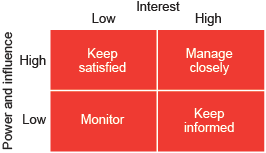2.2 Who is it a problem for?
Identifying who is affected by – and is affecting – the problem can be another useful way of looking at the issues involved. A ‘stakeholder analysis’ can give a picture of interests, values and tensions among stakeholders. It can also help to redefine or modify the problem because the real problem may be different from what was initially thought. The stakeholder analysis diagram in Figure 3 below should help you to do this. You might find it useful to use the People and Connections Map (page 68 of the DIY Toolkit [Tip: hold Ctrl and click a link to open it in a new tab. (Hide tip)] ) or the Personas Tool (page 74 of the DIY Toolkit) to start and support discussions here. This will help to ensure that everyone participates in the process.

This step will enable you to capture, compare and discuss different viewpoints on the problem. It will give you a better understanding of the problem, the values and interests of stakeholders and the potential conflict in those interests. Exploring these tensions is good, as it allows the problem to be unpacked. (Note that you are not trying to reconcile any stakeholder differences within this process, just to identify them as part of your problem definition.)
2.1 What is the key issue you are trying to address and why is it important?
